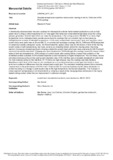JavaScript is disabled for your browser. Some features of this site may not work without it.
| dc.contributor.author | Beake, Ben D. | |
| dc.contributor.author | Endrino, José L. | |
| dc.contributor.author | Kimpton, Christine | |
| dc.contributor.author | Fox-Rabinovich, German S. | |
| dc.contributor.author | Veldhuis, Stephen C. | |
| dc.date.accessioned | 2017-11-20T12:53:59Z | |
| dc.date.available | 2017-11-20T12:53:59Z | |
| dc.date.issued | 2017-08-24 | |
| dc.identifier.citation | B.D. Beake, J.L. Endrino, C. Kimpton, G.S. Fox-Rabinovich, S.C. Veldhuis, (2017) Elevated temperature repetitive micro-scratch testing of AlCrN, TiAlN and AlTiN PVD coatings, International Journal of Refractory Metals and Hard Materials, Volume 69, December 2017, pp. 215-226 | en_UK |
| dc.identifier.issn | 0263-4368 | |
| dc.identifier.uri | https://doi.org/10.1016/j.ijrmhm.2017.08.017 | |
| dc.identifier.uri | https://dspace.lib.cranfield.ac.uk/handle/1826/12721 | |
| dc.description.abstract | In developing advanced wear-resistant coatings for tribologically extreme highly loaded applications such as high speed metal cutting a critical requirement is to investigate their behaviour at elevated temperature since the cutting process generates frictional heat which can raise the temperature in the cutting zone to 700–900 °C or more. High temperature micro-tribological tests provide severe tests for coatings that can simulate high contact pressure sliding/abrasive contacts at elevated temperature. In this study ramped load micro-scratch tests and repetitive micro-scratch tests were performed at 25 and 500 °C on commercial monolayer coatings (AlCrN, TiAlN and AlTiN) deposited on cemented carbide cutting tool inserts. AlCrN exhibited the highest critical load for film failure in front of the moving scratch probe at both temperatures but it was prone to an unloading failure behind the moving probe. Scanning electron microscopy showed significant chipping outside the scratch track which was more extensive for AlCrN at both room and elevated temperature. Chipping was more localised on TiAlN although this coating showed the lowest critical loads at both test temperatures. EDX analysis of scratch tracks after coating failure showed tribo-oxidation of the cemented carbide substrate. AlTiN showed improved scratch resistance at higher temperature. The von Mises, tensile and shear stresses acting on the coating and substrate sides of the interface were evaluated analytically to determine the main stresses acting on the interface. At 1 N there are high stresses near the coating-substrate interface. Repetitive scratch tests at this load can be considered as a sub-critical load micro-scale wear test which is more sensitive to adhesion differences than the ramped load scratch test. The analytical modelling showed that a dramatic improvement in the performance of AlTiN in the 1 N test at 500 °C could be explained by the stress distribution in contact resulting in a change in yield location due to the high temperature mechanical properties. The increase in critical load with temperature on AlTiN and AlCrN is primarily a result of the changing stress distribution in the highly loaded sliding contact rather than an improvement in adhesion strength. | en_UK |
| dc.language.iso | en | en_UK |
| dc.publisher | Elsevier | en_UK |
| dc.rights | Attribution-NonCommercial-NoDerivatives 4.0 International | |
| dc.rights.uri | http://creativecommons.org/licenses/by-nc-nd/4.0/ | |
| dc.subject | Scratch test | en_UK |
| dc.subject | Elevated temperature | en_UK |
| dc.subject | Nanomechanics | en_UK |
| dc.subject | AlCrN | en_UK |
| dc.subject | AlTiN | en_UK |
| dc.title | Elevated temperature repetitive micro-scratch testing of AlCrN, TiAlN and AlTiN PVD coatings | en_UK |
| dc.type | Article | en_UK |
| dc.identifier.cris | 18440061 |
Files in this item
This item appears in the following Collection(s)
-
Staff publications (SATM) [4358]

